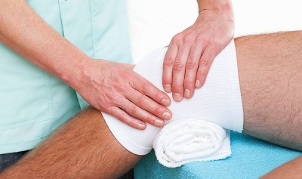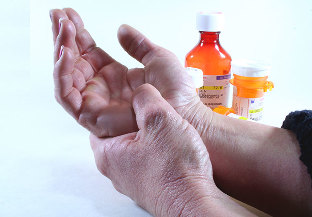The most common joint diseases are arthritis and degenerative joint disease. The two diseases have many differences, the outcome of which is largely dependent on. The correct identification of the disease by a specialist is the key to effective treatment that helps to completely restore the damaged joints. Under the impact of changes due to age, each person at risk of changes in joint disease. The joints are particularly affected, which are subject to increased stress throughout life. Illness can be a direct cause of joint changes. In order to prevent undesirable consequences from joint diseases, it is necessary to prevent disease development by observing preventive and therapeutic measures.
The main difference between osteoarthritis and osteoarthritis
Joint diseases: Arthritis and osteoarthritis negatively affect a patient's quality of life. The pathogenesis of the joints causes pain and limited movement. Both diseases lead to changes that destroy joint structure, but differ in the nature of the origin and course of the disease.
Arthritis, if we compare it to joint disease, is an acute or chronic inflammatory pathology of the joint that can emerge with infection or diseases of an autoimmune nature, becomingcomplications after trauma and also occur in case of allergic reactions.

Single and multiple joints are affected. In addition, the inflammatory process spreads throughout the body, involving internal organs in the process.
Osteoarthritis is a process of changing cartilage, resulting in the destruction of joints resulting in a complete loss of movement, like arthritis. A pathological process develops due to age-related changes in the tissues of the joints, exacerbated by the patient's excessive weight, metabolic disorders and pathology of the endocrine system.
The causes of arthritis and arthritis are significantly different. The only unifying factor is the similarity of some of the symptoms and the deplorable outcome of the untreated forms.
Arthritis agents:
- develops inflammation of the joint tissues of the knee after trauma of different nature;
- infection of the knee joint caused by viral, fungal and bacterial causes;
- severe allergy;
- long exposure to cold air;
- lacks vitamins and minerals;
- genetic predisposition.
The onset of arthritis differs from arthritis in the inevitable variation in every person of age. Knowing the cause of the disease, from an early age, it is possible to adjust diet and activities to prevent disease.
Evolution happens under the following conditions:
- abrasion of the components of the joint due to aging;
- increased body weight significantly increases the daily load on the knee;
- deformation disorder due to trauma;
- malnutrition; Arthritis
- can be a complication of arthritis, or rather inflammation, associated with the disease;
- unexplained autoimmune disease;
- congenital joint disease;
- violates the nutrition and supply of blood to the joints;
- malfunctioning thyroid;
- changes the level of hormones;
- polluted environment.
Difference Features
These two diseases may sound similar but are different in many ways. In the young population, up to the age of forties, arthritis is more common, and cartilage tissue destruction processes affect the elderly, the older the person the higher the risk.
Arthritis is a localized disease mainly in the joints, not spreading to surrounding organs and tissues. Arthritis can be one of the manifestations of a more serious illness involving the entire body in the inflammatory process. Both diseases can occur in acute and chronic form, with only joint disease that develops over a longer period can lead to complete destruction of the joint.
Arthritis has brighter symptoms, accompanied by the characteristic external manifestations of inflammation: congestion in the area of localization of the process, marked swelling, hot skin in the affected joint area, pain syndrome. The process of arthritis is smoother, does not spread beyond the joint.
Arthritis, in contrast to joint disease, often involves small joints in the process: the hands, feet, wrist joints and ankles. It rarely affects one joint, polyarthritis is a more common form, and fibrosis is localized to large joints.
According to statistics, middle-aged men are susceptible to joint diseases caused by infections and viruses. Disfiguration processes most commonly occur in women during menopause, mainly after the age of 50. Children can also suffer joint damage, in particular juvenile arthritis considered dangerous, which can be restrictive.
Expression token
It is important to seek medical advice when first having symptoms in order to successfully heal and restore joints for optimal motor performance. Arthritis and dry joints differ significantly in the early stages of the disease. Inflammation is manifested by the severity of symptoms, so it's easy not to miss the process of starting.
Dystrophic changes in joint tissue perform poorly at an early stage, so patients often see an orthopedist when the disease is in the second or third stage of development. In this case, the treatment is complex, prolonged and requires many measures to restore the normal function of the joint. The lumbering process is difficult to self-diagnose, but for any discomfort in the joints, you just need to see a doctor so you don't miss the early stages of the disease.
What is arthritis?
- Unlike osteoarthritis, with arthritis, swelling occurs around the inflamed joint, impeding movement and causing a lot of inconvenience when moving independently.
- In acute inflammation, the skin of the joints becomes congested and hot to the touch.
- If arthritis is caused by infection. The general state of the patient suffers, intoxication onset, accompanied by fever.
- Penetrating pain occurs in inflamed joints, which tends to increase significantly with movement. In a calm state, the pain syndrome does not subside but becomes active.
- In most cases, arthritis is accompanied by a general worsening of the condition, weakness appears and chronic illnesses worsen.
- The most vulnerable to damage are the knuckles and toes, as well as the ankles and hands.
Arthritis Symptoms
Manifestations of joint disease have no characteristic signs in the early years of the disease, wear and tear of the joint perceives itself after some stage of development of the condition.
Signs of joint disease:
- The pain
- does not appear immediately, the pain gradually increases as the condition of the joint worsens;
- in the absence of movement, pain does not arise, pain syndrome begins to develop with activation;
- in the case of damage to the hip or knee joint - gait becomes limp and the range of motion is insufficient;
- in neglected conditions, the lower extremities may be shortened, in the absence of correction, the pathologies of the spine develop;
- when the cartilage tissue is destroyed, the joint loses its mobility and the joint is completely blocked;
- severe crepitus in joints during physical activity.
How to treat the disease?

Arthritis and osteoarthritis differ significantly in their approach to treatment. The various causes and mechanisms of the development of the pathology suggest the initial setting of the correct diagnosis to effective therapeutic measures.
In order not to get sick and waste valuable time, don't rely on your friends' experiences and folk recipes.
Pathological processes that adversely affect joints are not allowed to take their course. It is important to feel active joy at all ages; not only one's happiness, but one's quality of life also depends on it.
Arthritis treatment
Treatment should begin with identifying inflammatory factors. After determining the nature of the origin of the disease, drugs are prescribed to destroy the pathogen of the pathology. When exposed to pathogenic bacteria, the patient is prescribed antibiotics, depending on the degree of toxicity, prescribed in the form of tablets or injections. Viral lesions are treated with antiviral drugs.
The basis for effective elimination of inflammation and pain relief will be mandatory nonsteroidal anti-inflammatory drugs. They will help to deal with undesirable symptoms, both when taking medication and acting locally on the affected joint.
Strengthening the immune system is the basis for successful disease control. Taking a multivitamin with micronutrients will support the weakened body and help turn the disease in the direction of recovery. In addition to synthetic complexes, natural sources of vitamins are also very helpful - berries, fruits, vegetables.
Adequate nutrition and special diet is indicated for patients with arthritis, as well as arthritis. Allowed products include fermented dairy products, lean meats, fish, vegetables, and herbs. You will have to give up strong coffee and black tea, carbonated drinks and alcohol.
The physiotherapy exercises and the physiotherapy procedures give great results when combined with the primary therapy: magnetic pulse therapy, radon baths, electrophoresis and others. List of special exercises performed by a physiotherapist, under the supervision of this person.
We treat arthritis
The disease grows slowly and there is a fundamentally different treatment aimed at restoring the cartilage tissue of the joint. The real salvation will be that the use of chondroprotectors, with prolonged use and in accordance with the recommendation of the doctor, can prevent the progression of destructive changes and restore damaged cells.
Chondroprotectors support tissue nutrition and promote cartilage repair, as well as increase the production of synovial fluid, serving as the sole source of nutrition for joints' components.
When pain occurs, NSAIDs are recommended for symptomatic treatment of the pain. Diet in moderation, quit alcohol, help the body increase resistance, increase fighting strength for healthy bones and joints.
Exercise therapy uses many methods to help increase blood circulation in the damaged area, move joints, increase movement. Traditional recipes, which have been tested over the years, are very useful as a complementary method of alternative medicine.
In the late stages of arthritis and arthritis, the only solution is surgical treatment of the bursae. The method commonly used is a cartilage implant, which can restore mobility to the affected joint.
How is the disease determined?
To determine exactly what disease is developing in the joint, you need to make an appointment with an experienced chiropractor. During the first meeting, the doctor will conduct a visual examination and ask questions of interest to help visualize the disease.
The results of a lab blood test will help differentiate arthritis from arthritis, which will require general and biochemical tests. X-rays will help check joint details from the inside.
In some diseases, the patient is referred to the magnetic resonance examination, which will answer the doctor's questions about the pathological diagnosis. After fully collecting the results, a diagnosis will be made, as a basis for prescribing treatment.
Precautions
Keeping your joints healthy requires a healthy lifestyle. Proper nutrition and regular exercise will prolong the life of the joint, which is very important for overall health.
At the slightest manifestation of dry joints or arthritis, you should not undergo self-treatment. Inappropriate actions can negatively affect the outcome of the disease. A timely referral to a therapist and more adherence to appointments will ensure a successful treatment, helping you lead a healthy lifestyle.







































